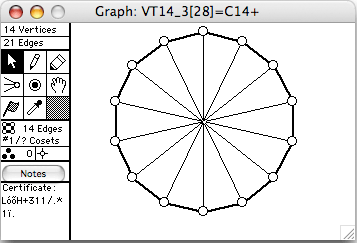Last update=23 May, 2006

There are 51 connected vertex-transitive graphs on 14 vertices. There are 3 of degree 3 (21 edges), and 5 of degree 4 (28 edges). These are shown here. The order of the automorphism group is given in square brackets in each window's title.
Notation:
- Cn means the cycle of length n
- Cn+ means the cycle of length n with diagonals
- Cn(k) means the cycle of length n with chords of length k
- Cn(k+) means the cycle of length n with chords of length k from every second vertex
- ~G means the complement of G
- 2G means two disjoint copies of G
- GxH means the direct product of G and H
- Prism(m) means CmxK2, ie, two cycles with corresponding vertices joined by a matching
- BiDbl(G) means the bipartite double of G. Make 2 copies of V(G), call them u1,...,un and v1,...,vn. If uv is an edge of G, then u1v2 and v1u2 are edges of BiDbl(G)
- Dbl(G) means the double of G. Make 2 copies of G, call them G1 and G2. If uv is an edge of G, then u1v2 and v1u2 are also edges of Dbl(G)
- Dbl+(G) means the double of G, with the additional edges u1u2
- antip(G) means the antipodal graph of G. It has the same vertices, but u and v are joined in antip(G) if they are are maximum distance in G
The complements of the graphs shown here and the complements of the disconnected transitive graphs are:
- VT12_39 = ~C14(4)
- VT12_40 = ~2C7(2)
- VT12_41 = ~C14(2)
- VT12_42 = ~C14(6)=~Dbl(C7)
- VT12_43 = ~antip(Heawood)
- VT12_44 = ~C14(3)=~BiDbl(C7(2))
- VT12_45 = ~(C7xK2)=~Prism(7)
- VT12_46 = ~C14+
- VT12_47 = ~Heawood
- VT12_48 = ~2C7
- VT12_49 = ~C14
- VT12_50 = ~7K2
- VT12_51 = ~K7
- VT12_40 = ~2C7(2)
The Heawood graph is the incidence graph of the Fano plane, the unique projective plane with 7 points and 7 lines. The Heawood graph is also known as the (3,6)-cage. It is also the dual of the unique embedding of K7 on the torus, which is basically how Heawood discovered it.
 |
 |
 |
 |
 |
 |
 |
 |

 Back to the Groups & Graphs home page.
Back to the Groups & Graphs home page.